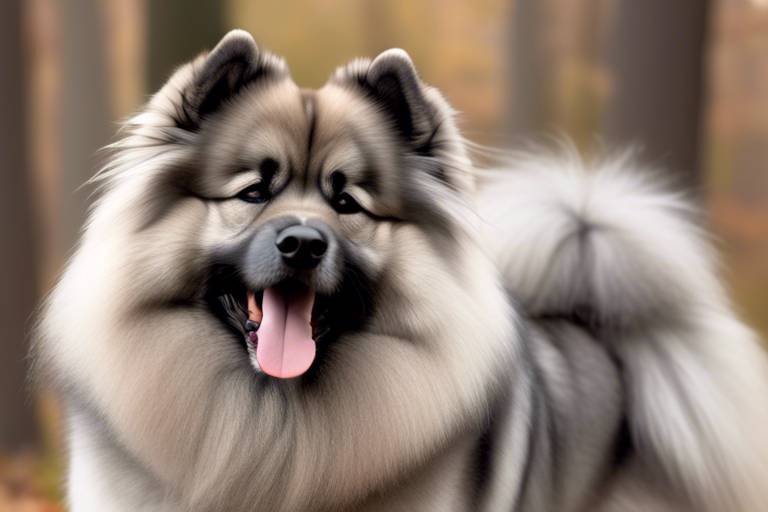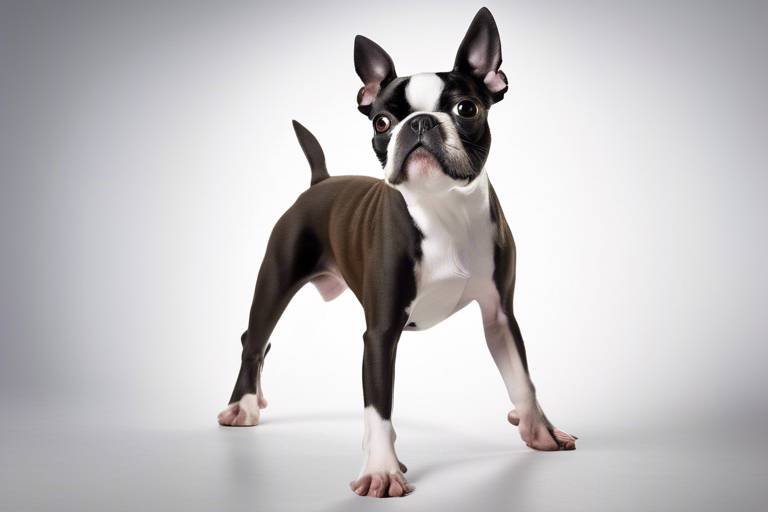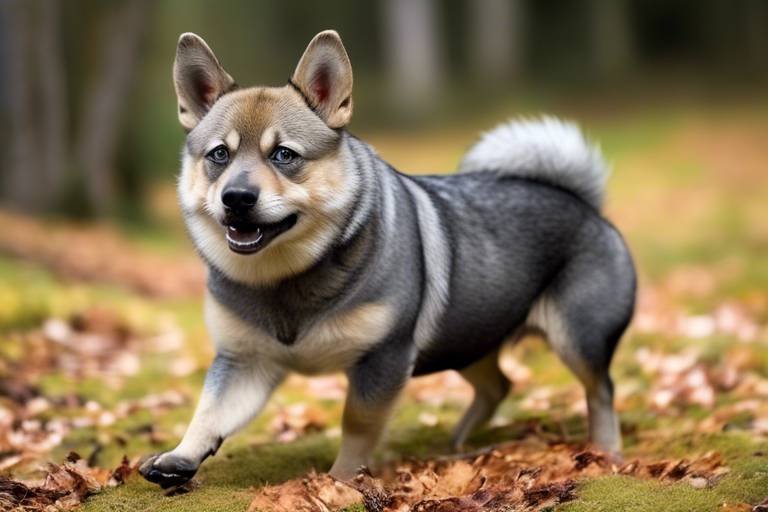Understanding the Characteristics of the Keeshond
The Keeshond is not just another pretty face in the dog world; it's a breed that encapsulates a unique blend of charm and charisma. If you’ve ever seen one, you know that their striking appearance is hard to forget. With a fox-like face, distinctive markings, and a luxurious double coat, Keeshonds are often the center of attention wherever they go. But it's not just their looks that make them stand out; their temperament and behavior are equally captivating. In this article, we will delve into the physical attributes, grooming needs, and the suitability of Keeshonds as family pets, ensuring that you have a comprehensive understanding before welcoming one into your home.
The Keeshond’s physical appearance is nothing short of stunning. Their double coat, which consists of a soft undercoat and a long, flowing outer coat, gives them a fluffy and regal look. This breed typically stands between 17 to 18 inches tall and weighs around 35 to 45 pounds, making them a medium-sized dog that's perfect for both apartments and houses with yards. Their eyes are dark and expressive, often described as having a mischievous glint that reflects their playful nature. The markings on their face, particularly the 'spectacles' around their eyes, add to their charm and make them instantly recognizable. However, this beautiful coat comes with responsibilities; regular grooming is essential to keep their fur healthy and free from matting.
Keeshonds are known for their friendly and alert disposition. They are intelligent dogs that thrive on companionship and social interaction. Their sociable nature makes them excellent companions, not just for individuals but also for families. Keeshonds are often described as clowns of the dog world, always ready to entertain and engage with their family members. Their protective instincts make them vigilant watchdogs, alerting their owners to any unusual sounds or intruders. This combination of friendliness and protectiveness is what makes Keeshonds a popular choice for families looking for a loyal and loving pet.
Proper socialization is crucial for Keeshonds to develop well-rounded personalities. Early exposure to various environments, people, and other pets can help them become confident and well-adjusted adults. It's essential to introduce them to a variety of experiences during their formative months. Think of it as giving them a toolkit for life; the more tools they have, the better equipped they are to handle different situations. This will not only enhance their behavior but also ensure they grow up to be well-mannered companions.
When it comes to children, Keeshonds generally shine. They are known for their patience and playfulness, making them ideal companions for kids. Supervised interactions can foster strong bonds between Keeshonds and children, allowing both to learn from each other. Imagine a fluffy ball of energy bouncing around, playing fetch or simply enjoying a belly rub; that’s a Keeshond with a child. Their gentle nature ensures that they can handle the occasional rough play without losing their cool, making them a perfect fit for active households.
Keeshonds are typically very sociable and get along well with other pets, especially when introduced at a young age. Their friendly disposition allows them to coexist harmoniously in multi-pet households. If you have other furry friends at home, you’ll find that Keeshonds can adapt well, often becoming the peacekeepers of the pack. They thrive on companionship, so having a buddy around can make them even happier!
Training a Keeshond can be a rewarding experience due to their intelligence and eagerness to please. They respond best to consistent, positive reinforcement methods, which encourage good behavior and obedience. Think of training sessions as a fun game rather than a chore. With the right approach, you’ll find that teaching them commands or tricks is not only effective but also enjoyable for both you and your dog. Remember, a mentally stimulated Keeshond is a happy Keeshond!
To maintain a Keeshond's beautiful coat, regular grooming is essential. Their double coat can easily become matted if not cared for properly, and shedding can be a concern if grooming is neglected. Understanding their grooming needs is crucial for keeping them healthy and looking their best. Think of grooming as a bonding experience; it’s not just about aesthetics but also about ensuring your furry friend feels comfortable and loved.
Regular brushing helps remove loose fur and prevent tangles. Investing in a good quality brush designed for double-coated breeds can make a world of difference. Aim to brush your Keeshond at least once a week, or more often during shedding seasons. This not only keeps their coat looking fabulous but also minimizes the amount of fur around your home. Plus, many Keeshonds enjoy the attention they receive during grooming sessions!
Bathing should be done as needed to maintain coat cleanliness and skin health. Using a gentle, dog-specific shampoo will enhance the Keeshond's natural beauty and comfort. Overbathing can strip their coat of essential oils, so it’s important to find a balance. Typically, a bath every few months should suffice unless they get into something messy. Remember, a clean dog is a happy dog!
- Are Keeshonds good for first-time dog owners? Yes, their friendly nature and intelligence make them suitable for first-time owners who are willing to invest time in training and socialization.
- How much exercise do Keeshonds need? Keeshonds require regular exercise, such as daily walks and playtime, to keep them happy and healthy.
- Do Keeshonds shed a lot? Yes, they do shed, especially during seasonal changes, so regular grooming is essential.
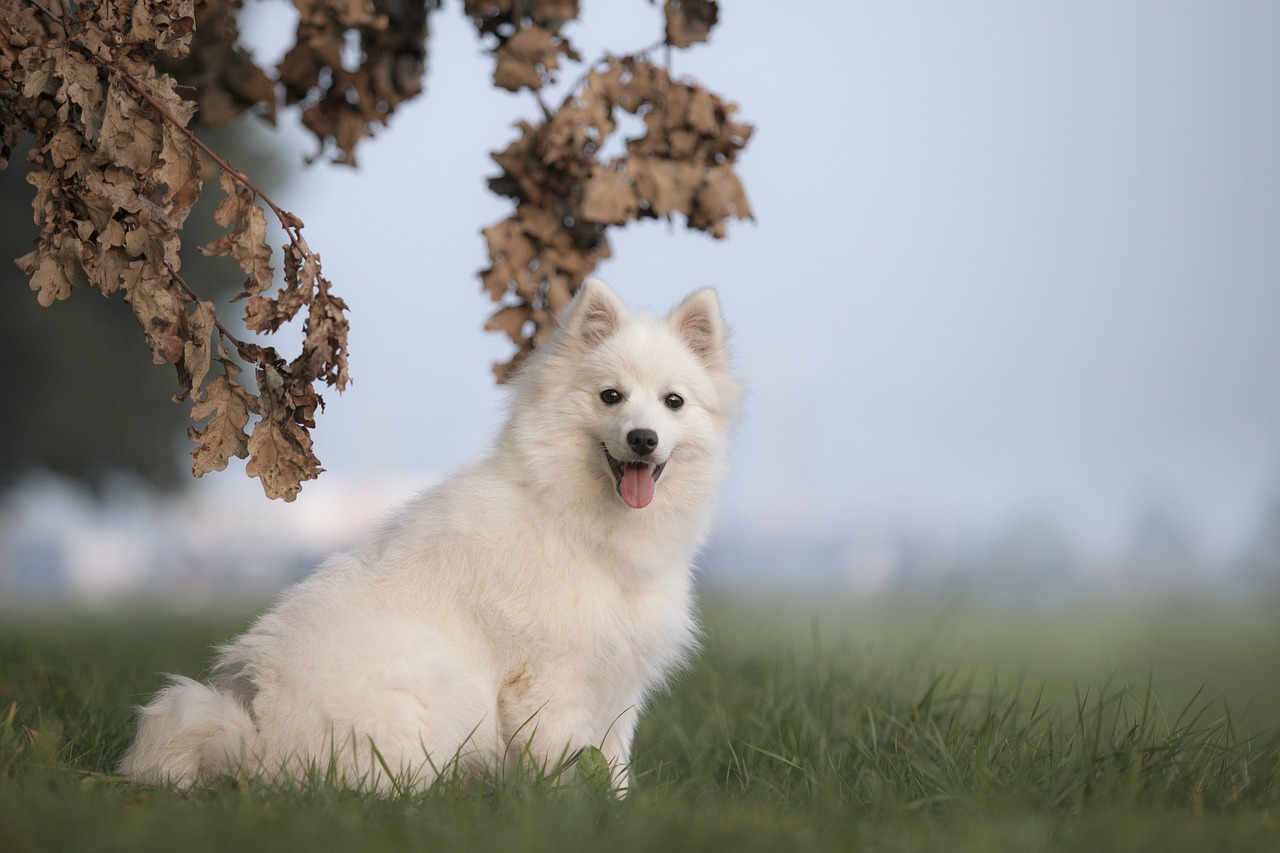
Physical Appearance
The Keeshond is truly a sight to behold, often turning heads with its striking appearance. Imagine a dog with a fox-like face, complete with a bushy tail that curls over its back and a luxurious double coat that exudes elegance. The Keeshond's coat is a beautiful blend of colors, primarily shades of gray and black, accentuated by a distinctive facial mask that gives it a charming expression. This breed's physical attributes not only make it adorable but also serve practical purposes, such as insulation against cold weather.
When you look closely, you'll notice that the Keeshond's coat is composed of two layers: a soft undercoat that provides warmth and a longer outer coat that protects against the elements. This combination is essential for keeping the Keeshond comfortable in various climates. However, this gorgeous coat does come with a responsibility—regular grooming is necessary to prevent matting and to keep shedding under control. Without proper care, the Keeshond's coat can become tangled, losing its luster and beauty.
In terms of size, Keeshonds are considered a medium-sized breed, typically weighing between 35 to 45 pounds and standing about 17 to 18 inches tall at the shoulder. Their sturdy build and confident stance contribute to their overall appealing presence. The breed's expressive eyes, often described as dark and almond-shaped, are framed by those characteristic markings that give them a watchful yet friendly look. Their ears are triangular and erect, adding to their alert demeanor, making them look like they are always ready for action.
To further illustrate the Keeshond's physical characteristics, here’s a quick comparison table:
| Feature | Description |
|---|---|
| Size | Medium (17-18 inches tall) |
| Weight | 35-45 pounds |
| Coat | Double coat (soft undercoat, longer outer coat) |
| Color | Gray, black, cream, and silver |
| Eyes | Dark, almond-shaped |
In summary, the Keeshond is not just another cute face in the dog world; its unique physical traits make it a standout breed. With a combination of beauty and practicality, this dog is sure to be a delightful addition to any family. Just remember, while their appearance is captivating, it’s the care and attention you provide that will keep them looking their best!
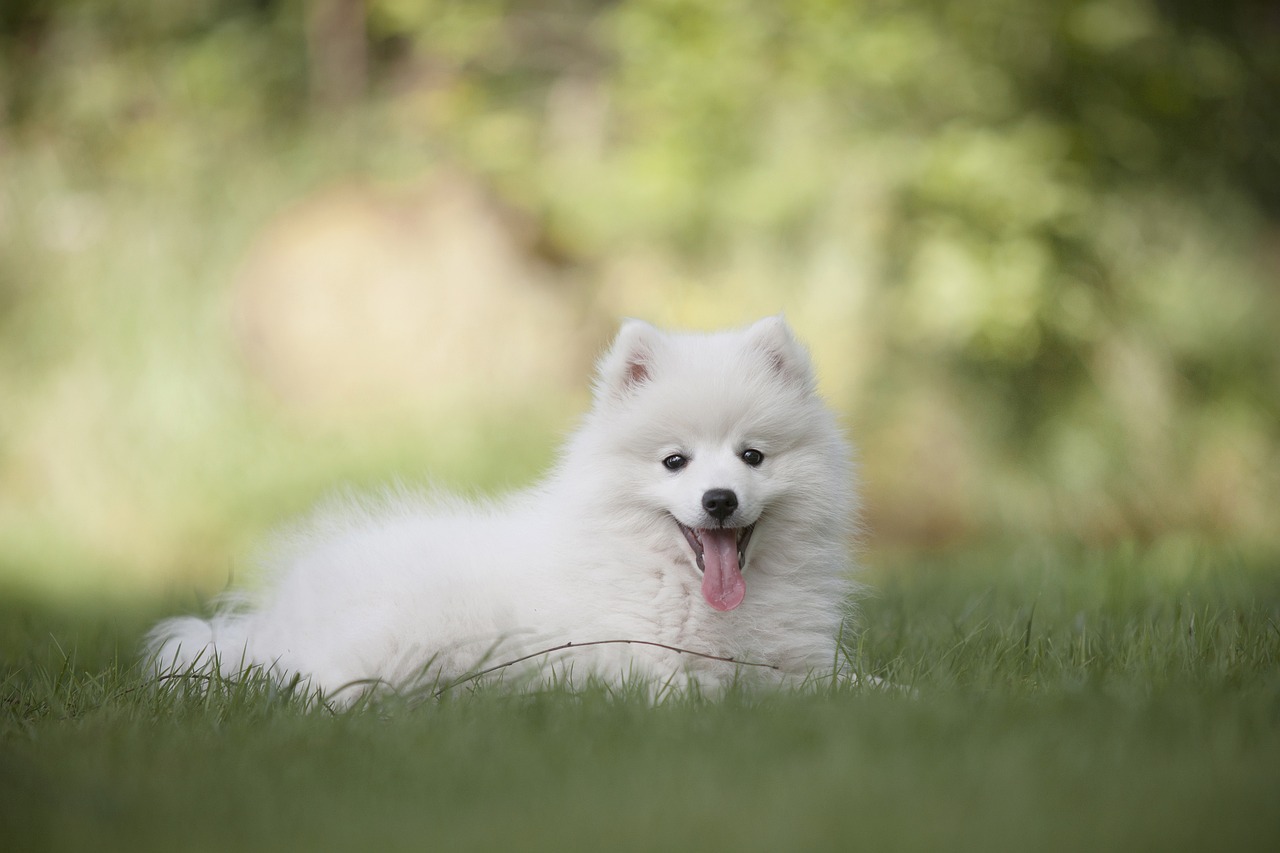
Temperament and Behavior
The Keeshond is not just a pretty face; it boasts a personality that is as engaging as its striking appearance. These dogs are known for their friendly and alert demeanor, making them superb companions for families and individuals alike. Their sociable nature allows them to bond well with humans and other pets, which is a significant factor in their popularity. Imagine having a furry friend who not only greets you with excitement when you come home but also keeps a keen eye on everything happening around them—this is the essence of a Keeshond!
One of the most endearing traits of Keeshonds is their intelligence. They are quick learners and thrive on mental stimulation, which is essential for their well-being. This breed is often described as people-oriented, meaning they crave interaction and affection from their owners. If you've ever met a Keeshond, you might have noticed how they seem to have a sixth sense about their human's emotions, responding with a comforting nuzzle or a playful bark when you need it most. Their protective instincts make them vigilant watchdogs, always on alert for any unusual activity, which adds another layer of security to your home.
To cultivate a well-rounded personality, proper socialization is crucial for Keeshonds. Early exposure to a variety of environments, people, and other pets can significantly influence their behavior as adults. Think of socialization as a foundation for their personality; the more diverse experiences they have, the more confident and adaptable they become. Whether it’s a trip to the park or a visit to a friend’s house, introducing your Keeshond to new situations can help them develop into a well-adjusted adult.
When it comes to children, Keeshonds are generally great companions. Their patience and playful nature make them perfect playmates for kids. However, it’s essential to supervise interactions to ensure that both the child and the dog feel comfortable and safe. Keeshonds thrive in active households where they can engage in play and receive plenty of attention. Picture a scene where your Keeshond is happily chasing after a ball, with children laughing and running alongside—this is the joy they bring to family life.
Another remarkable aspect of Keeshonds is their compatibility with other pets. They typically get along well with fellow furry friends, especially when introduced at a young age. Their friendly disposition allows them to coexist harmoniously in multi-pet households. If you already have pets, a Keeshond can fit right into your family dynamic, bringing a sense of joy and companionship to all members of the household.
Training a Keeshond can be an enjoyable experience, thanks to their eagerness to please. These intelligent dogs respond well to consistent, positive reinforcement methods, which encourage good behavior and obedience. Think of training as a game; the more fun and engaging it is, the better your Keeshond will perform. Incorporating treats, praise, and play into your training sessions can help solidify your bond while teaching them essential commands.
| Key Traits | Description |
|---|---|
| Friendliness | Keeshonds are known for their sociable and loving nature. |
| Intelligence | They are quick learners and enjoy mental challenges. |
| Protectiveness | They serve as vigilant watchdogs, alerting owners to any unusual activities. |
| Compatibility | They generally get along well with children and other pets. |
In summary, Keeshonds are not just beautiful dogs; they are also filled with personality traits that make them wonderful companions. Their friendly, intelligent nature, combined with their protective instincts, creates a unique blend that is hard to resist. Whether you’re looking for a family pet or a loyal companion, the Keeshond is sure to bring happiness into your life.
- Are Keeshonds good with children? Yes, Keeshonds are generally very good with children and enjoy their playful nature.
- How much grooming do Keeshonds require? Keeshonds need regular grooming to maintain their double coat and prevent matting.
- Do Keeshonds get along with other pets? Yes, they typically do well with other pets, especially if introduced at a young age.
- How intelligent are Keeshonds? Keeshonds are quite intelligent and eager to please, making them relatively easy to train.
Socialization Needs
When it comes to raising a Keeshond, one of the most important aspects to consider is their . Think of socialization as the foundation of a well-rounded dog. Just like humans, Keeshonds thrive on interaction and exposure to different environments. Early socialization is crucial; it helps these intelligent pups grow into confident and adaptable adults. Imagine a sponge soaking up water; that’s how Keeshonds absorb experiences during their formative months. The more diverse their experiences, the more balanced their personalities will become.
To set your Keeshond up for success, it’s essential to introduce them to a variety of people, places, and situations. This could mean taking them to the local park, visiting friends' homes, or simply going for walks in different neighborhoods. The goal is to expose them to different sights, sounds, and smells, which will help them learn how to react appropriately in various situations. You might be surprised at how quickly they adapt, as Keeshonds are naturally curious and eager to explore the world around them.
Another key aspect of socialization is interaction with other dogs and pets. If you have other animals at home, introducing them to your Keeshond from a young age can foster a harmonious household. Dogs are social creatures, and a Keeshond that is well-socialized with other pets will be more comfortable and less likely to develop behavioral issues. Consider enrolling your Keeshond in puppy classes or dog parks, where they can meet and play with other dogs. This not only helps with social skills but also provides a fantastic outlet for their energy.
It’s also important to note that socialization is an ongoing process. Even after the puppy stage, continue to expose your Keeshond to new experiences. This could involve taking them on road trips, visiting pet-friendly stores, or even attending dog-friendly events. The more experiences they have, the more resilient they become. Just like a well-rounded person, a well-socialized Keeshond will be more adaptable and less fearful of the unknown.
In summary, the socialization needs of a Keeshond are vital for their development. By providing a variety of experiences and interactions, you’re not just raising a pet; you’re nurturing a confident companion. Remember, a well-socialized Keeshond is not only a joy to be around but also a loyal friend who can handle whatever life throws their way.
- How early should I start socializing my Keeshond? It's best to begin socialization as early as possible, ideally during the critical puppy stage, which is around 3 to 14 weeks old.
- What are the best ways to socialize my Keeshond? Take them to different environments, introduce them to various people and pets, and consider puppy classes or dog parks for structured socialization.
- Can a Keeshond be socialized later in life? Yes, while early socialization is ideal, older Keeshonds can still learn and adapt. However, it may take more time and patience.
- What if my Keeshond is shy or fearful? Gradually introduce them to new experiences and ensure that each encounter is positive. Patience and positive reinforcement are key.
Interaction with Children
The Keeshond is often celebrated for its gentle and playful nature, making it an excellent companion for children. These dogs are not just pets; they become part of the family, and their interactions with kids can be both delightful and enriching. Imagine a fluffy ball of energy, wagging its tail as it runs around the yard, with children laughing and playing alongside. That’s the essence of a Keeshond's interaction with kids—full of joy and companionship.
One of the most remarkable traits of Keeshonds is their patience. They tend to be very tolerant of the antics that children often display, whether it’s a little one pulling on their fur or attempting to dress them up in silly costumes. This breed possesses a natural affinity for children, often engaging in games of fetch or simply enjoying a good belly rub. However, it’s essential to supervise these interactions to ensure that both the child and the dog are safe and comfortable.
To foster a harmonious relationship between Keeshonds and children, here are some tips to consider:
- Teach Respect: Educate children on how to approach and interact with the dog. Gentle petting and calm voices can make a significant difference.
- Encourage Play: Engage in activities that allow both the Keeshond and the children to expend energy together, such as playing fetch or going for walks.
- Establish Boundaries: Ensure that children understand when the dog needs space, especially during meal times or when the dog is resting.
By nurturing these interactions, Keeshonds can become not just pets but lifelong friends to children, teaching them valuable lessons about responsibility, empathy, and unconditional love. The bond formed between a Keeshond and a child can be a beautiful thing, often leading to cherished memories that last a lifetime. So, if you're considering adding a Keeshond to your family, you can rest assured that your children will have a loyal and loving companion by their side.
Q: Are Keeshonds good with young children?
A: Yes, Keeshonds are generally very good with young children due to their friendly and patient temperament. However, supervision is always recommended to ensure safe interactions.
Q: How can I help my Keeshond adjust to living with children?
A: Gradual introductions and positive reinforcement can help your Keeshond adjust. Encourage playtime and teach children how to interact gently with the dog.
Q: Do Keeshonds require special training when living with kids?
A: While Keeshonds are intelligent and eager to please, basic obedience training is beneficial. Teaching commands like "sit," "stay," and "gentle" can enhance their behavior around children.
Compatibility with Other Pets
The Keeshond is often celebrated for its friendly and adaptable nature, which extends to its relationships with other pets. When introduced properly, Keeshonds can easily coexist with various animals, including cats and smaller pets. Their sociable demeanor and playful spirit allow them to form strong bonds, making them excellent companions in multi-pet households. However, it’s important to consider a few key factors to ensure harmonious living.
First and foremost, early socialization is crucial. Exposing your Keeshond to different pets during their formative months can significantly influence their behavior as adults. A well-socialized Keeshond is more likely to approach new pets with curiosity rather than aggression. For instance, if you have a cat, introducing them to your Keeshond while both are still young can lead to a bond that resembles that of siblings, filled with playful interactions.
Moreover, Keeshonds are known for their playful and gentle temperament. They tend to have a natural affinity for play, which can be a great asset when integrating them with other pets. However, it's essential to supervise their interactions, especially in the beginning. A simple game of chase can be fun, but it’s important to ensure that all pets involved are comfortable and safe. Here are a few tips to keep in mind:
- Introduce gradually: Allow the Keeshond to sniff and explore the new pet in a controlled environment to reduce anxiety.
- Monitor behavior: Watch for signs of stress or aggression in either pet and intervene if necessary.
- Provide separate spaces: Ensure each pet has its own space to retreat to when feeling overwhelmed.
In addition to these tips, it's also essential to consider the energy levels of the pets involved. Keeshonds are active and energetic, often requiring plenty of playtime and exercise. If you have a more sedentary pet, ensure that their needs are also met. This balance can help prevent any tension that might arise from differing activity levels.
In summary, Keeshonds are typically very compatible with other pets, especially when introduced at a young age. Their friendly disposition allows them to coexist harmoniously in multi-pet households, provided that proper introductions and socialization practices are followed. With a little patience and understanding, your Keeshond can become a beloved member of a diverse family of pets.
- Are Keeshonds good with cats? Yes, Keeshonds can be good with cats, especially if they are introduced at a young age.
- How can I help my Keeshond get along with other pets? Early socialization, gradual introductions, and monitoring interactions are key to fostering good relationships.
- What should I do if my Keeshond shows aggression towards another pet? It’s important to intervene immediately, separate the pets, and consult a professional trainer if necessary.
Training and Intelligence
The Keeshond is not just a pretty face; they're also known for their remarkable intelligence and eagerness to please. This breed is like a sponge, ready to soak up knowledge and commands with enthusiasm. If you've ever had a conversation with someone who's genuinely excited about learning, you can imagine how a Keeshond approaches training. They thrive on interaction and positive reinforcement, making the training process not only effective but also enjoyable for both the dog and the owner.
When it comes to training, consistency is key. Keeshonds respond best to positive reinforcement methods, which means rewarding them for good behavior rather than punishing them for mistakes. This approach helps foster a trusting relationship between you and your furry friend. Imagine teaching a child; if you only focus on what they did wrong, they'll likely lose motivation. But if you celebrate their successes, they’ll be eager to learn more. The same principle applies to Keeshonds.
One effective way to train a Keeshond is through the use of short, engaging sessions. These dogs have a natural curiosity and a playful spirit, so keeping training sessions fun and brief can prevent boredom. Aim for sessions that last about 5 to 10 minutes, focusing on one command or trick at a time. This method not only keeps their attention but also allows them to absorb the information better. You might find that your Keeshond is picking up commands faster than you can keep up!
Socialization is another critical aspect of training. Exposing your Keeshond to various environments, people, and other animals will help them become well-rounded and confident. Think of it like introducing a child to new experiences; the more they see and do, the more adaptable they become. Early socialization can prevent behavioral issues down the road, ensuring your Keeshond grows into a well-adjusted adult.
In terms of intelligence, Keeshonds are often compared to other breeds like the Border Collie or the Poodle. While they may not be the absolute top-tier in obedience rankings, they are certainly among the smarter breeds. This means they can learn a variety of commands and tricks, from basic obedience to more advanced tasks. Here’s a quick overview of some training commands that Keeshonds typically excel at:
| Command | Difficulty Level | Training Tip |
|---|---|---|
| Sit | Easy | Use treats to lure them into position. |
| Stay | Moderate | Gradually increase the distance before rewarding. |
| Come | Easy | Use a long leash for better control during training. |
| Roll Over | Moderate | Use a treat to guide them through the motion. |
| Heel | Challenging | Practice in a distraction-free area before moving to busy places. |
As you embark on this training journey with your Keeshond, remember that patience is essential. Just like any relationship, building a strong bond with your dog takes time and effort. Celebrate the small victories, and don’t get discouraged by setbacks. With love, consistency, and a sprinkle of fun, your Keeshond will not only learn commands but also become a cherished member of your family.
- How long does it take to train a Keeshond? Training can vary depending on the individual dog, but many Keeshonds can learn basic commands within a few weeks with consistent practice.
- Are Keeshonds good for first-time dog owners? Yes! Their friendly nature and eagerness to please make them suitable for first-time dog owners, provided they receive proper training and socialization.
- Do Keeshonds require a lot of exercise? While they are active dogs, Keeshonds don’t require excessive exercise. Daily walks and playtime will keep them happy and healthy.
- Can Keeshonds be left alone for long periods? Keeshonds are social dogs and prefer companionship. Leaving them alone for extended periods may lead to separation anxiety.
- What is the best way to socialize a Keeshond? Gradually expose them to different environments, people, and pets. Puppy classes or dog parks can be great for socialization.
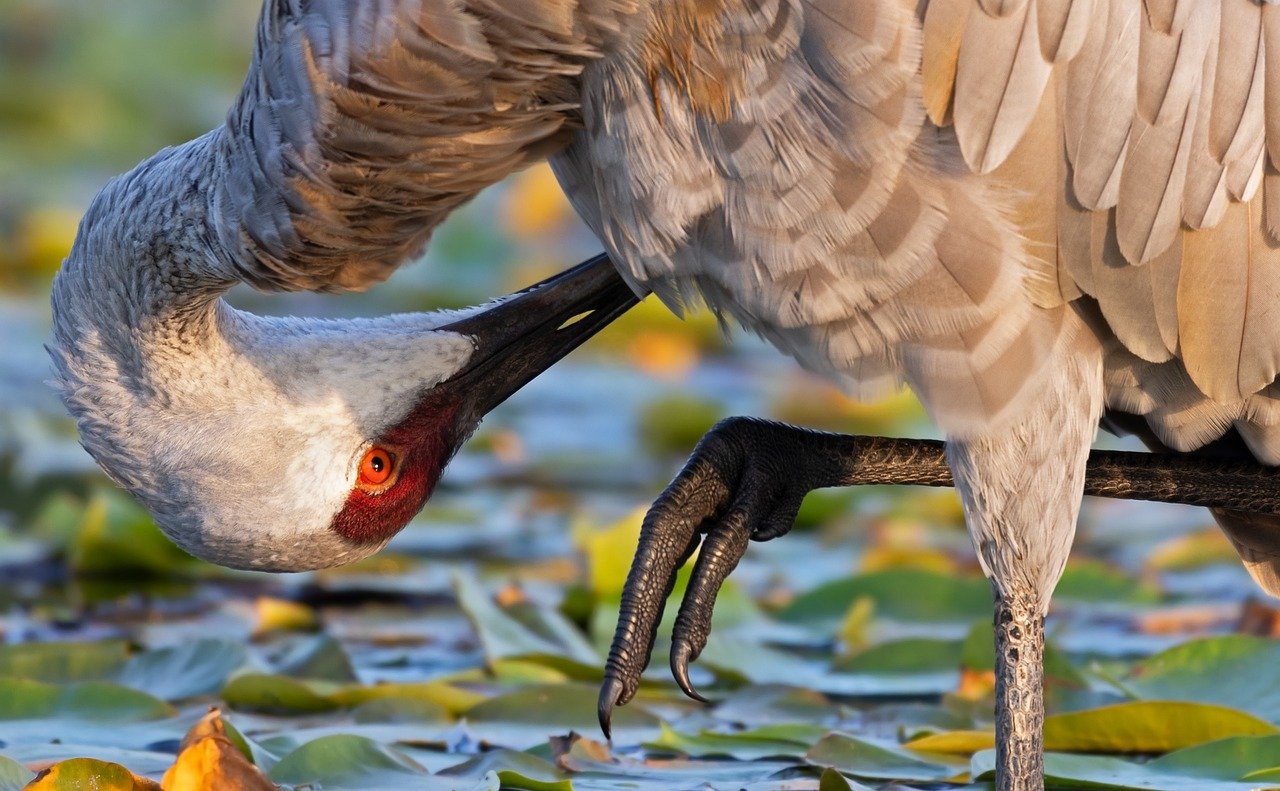
Grooming Requirements
The Keeshond is not just a pretty face; their stunning double coat is one of their most defining features. However, with great beauty comes great responsibility! Regular grooming is essential to keep their coat looking its best and to maintain their overall health. This breed's luxurious fur can easily become tangled and matted if not properly cared for, which can lead to discomfort for your furry friend. So, let’s dive into the grooming requirements that every Keeshond owner should know.
First and foremost, brushing is a crucial part of a Keeshond's grooming routine. Ideally, you should brush your Keeshond at least two to three times a week, and more frequently during shedding seasons. This not only helps to remove loose hair but also promotes healthy skin by distributing natural oils throughout their coat. Using the right tools can make this task a breeze. A slicker brush or an undercoat rake works wonders in getting through their thick fur. Imagine brushing through a fluffy cloud—that’s how satisfying it can be when you see all the loose fur coming out!
When it comes to bathing, the Keeshond doesn’t need frequent baths unless they get particularly dirty. Bathing them every 6 to 8 weeks is generally sufficient, as over-bathing can strip their coat of essential oils, leaving it dry and brittle. When you do bathe them, opt for a high-quality dog shampoo that’s gentle on their skin. Rinse thoroughly to ensure no soap residue remains, as this can cause irritation. Think of it as giving your Keeshond a spa day, complete with a gentle massage and a warm rinse—who wouldn’t love that?
Another aspect of grooming that often gets overlooked is nail trimming. Keeping your Keeshond’s nails trimmed is essential not only for their appearance but also for their comfort and health. Long nails can cause discomfort when walking and can even lead to joint issues over time. Aim to trim their nails every 3 to 4 weeks, or whenever you hear them clicking on the floor. If you're unsure how to do this, don’t hesitate to ask your vet for guidance. It’s like giving your dog a pedicure, and they’ll appreciate the care!
In addition to brushing, bathing, and nail trimming, dental care is another crucial component of grooming. Keeshonds are prone to dental issues, so regular teeth brushing should be part of their routine. Ideally, you should brush their teeth several times a week using toothpaste specifically formulated for dogs. This simple act can save you from costly vet bills down the road and keep your Keeshond's breath fresh. It’s like a little mint for their mouth!
In summary, grooming a Keeshond is a rewarding experience that strengthens the bond between you and your pet. By committing to a regular grooming schedule, you can ensure that your Keeshond remains healthy, happy, and stunningly beautiful. Remember, grooming isn’t just about looks; it’s a vital part of their overall well-being. So, roll up your sleeves, grab those grooming tools, and enjoy the time spent with your beloved Keeshond!
- How often should I groom my Keeshond? Regular brushing is recommended at least 2-3 times a week, with more frequent sessions during shedding seasons.
- Can I bathe my Keeshond too often? Yes, over-bathing can strip their coat of natural oils. Bathing every 6-8 weeks is usually sufficient.
- What tools do I need for grooming? A slicker brush, undercoat rake, nail clippers, and dog-safe shampoo are essential for grooming your Keeshond.
- How can I keep my Keeshond's teeth healthy? Regular brushing with dog-specific toothpaste can help prevent dental issues and keep their breath fresh.
Brushing Techniques
When it comes to keeping your Keeshond looking fabulous, mastering the art of brushing is essential. The Keeshond's luxurious double coat, which consists of a soft undercoat and a longer outer coat, can easily become tangled and matted if not cared for properly. Regular brushing not only helps to maintain their stunning appearance but also promotes healthy skin and reduces shedding around your home. So, how do you go about this? Let's dive into some effective brushing techniques that will make grooming a breeze!
First and foremost, it's important to choose the right tools. A slicker brush is generally recommended for Keeshonds, as it effectively removes loose fur and helps to detangle any knots. Additionally, a metal comb can be used for finer work, especially around sensitive areas like the face and legs. Investing in quality grooming tools is like having the right paintbrush for an artist – it makes all the difference in achieving a masterpiece!
To get started, find a comfortable space where you and your Keeshond can bond during grooming sessions. It's best to brush your furry friend at least once a week, but during shedding seasons, you might want to increase this frequency to two or three times a week. Begin by gently brushing through the outer coat, working in sections. Always brush in the direction of hair growth to avoid causing discomfort. If you encounter any tangles, use your fingers to gently separate the fur before going in with the brush.
Here's a quick overview of the brushing process:
- Start with a slicker brush: This will help remove loose fur and prevent mats.
- Use a metal comb: For finer areas, especially around the face and legs.
- Brush in the direction of hair growth: This minimizes discomfort and maximizes effectiveness.
- Take your time: Make grooming a positive experience by offering treats and praise.
Another handy tip is to brush your Keeshond while they're relaxed, perhaps after a nice walk or play session. This way, they associate grooming with positive experiences. Remember, your Keeshond is not just a pet; they're a member of your family, and spending quality time together during grooming can strengthen your bond. Plus, who doesn’t love a fluffy cuddle buddy?
Lastly, don't forget to check for any skin irritations or unusual lumps while grooming. This is a great opportunity to keep a close eye on your dog's health. If you notice anything out of the ordinary, consult your veterinarian. After all, a happy, healthy Keeshond is the best kind of Keeshond!
| Question | Answer |
|---|---|
| How often should I brush my Keeshond? | At least once a week, but more frequently during shedding seasons. |
| What tools do I need for grooming? | A slicker brush and a metal comb are recommended for effective grooming. |
| Can I bathe my Keeshond after brushing? | Yes, bathing can be done as needed, but ensure to use dog-friendly shampoo. |
| What should I do if I find a mat? | Gently work through the mat with your fingers before using a brush. |
Bathing Guidelines
Bathing your Keeshond is an essential part of their grooming routine, but it’s important to do it correctly to maintain their coat's health and vibrancy. Unlike some breeds that require frequent baths, Keeshonds only need to be bathed when they start to smell or their coat appears dirty. This typically translates to every 4 to 6 weeks, depending on their activity level and environment. Overbathing can strip the natural oils from their skin, leading to dryness and irritation. So, how do you know when it's time for a bath? Look for signs like a greasy feel to their fur or a noticeable odor.
When you’re ready to bathe your Keeshond, gather the necessary supplies first. You’ll need a high-quality dog shampoo that is gentle and specifically formulated for canine skin. Avoid using human shampoos, as they can be too harsh and disrupt the pH balance of your dog’s skin. Additionally, have a brush handy for a pre-bath grooming session. This helps remove loose fur and tangles, making the bathing process smoother.
Here’s a simple step-by-step guide to make bath time a breeze:
- Brush Before Bathing: Always brush your Keeshond before bathing. This helps to remove loose hair and prevents matting.
- Use Lukewarm Water: Fill the tub or shower with lukewarm water. Too hot or too cold water can be uncomfortable for your dog.
- Wet Gradually: Start by wetting your Keeshond's coat gradually, avoiding their head initially. Use a handheld showerhead or a cup to pour water over their body.
- Shampoo Gently: Apply the shampoo, lathering it gently into their coat. Pay special attention to areas that tend to get dirtier, like under the belly and between the paws.
- Rinse Thoroughly: Make sure to rinse all the shampoo out of their coat. Residue can cause skin irritation, so take your time with this step.
- Drying: After rinsing, gently towel dry your Keeshond. You can also use a blow dryer on a low setting, but be sure to keep it at a safe distance to avoid overheating their skin.
After the bath, it’s a great time to give your Keeshond some extra love and attention. They may feel a bit vulnerable after getting wet, so a few treats and cuddles can help make the experience positive. Additionally, consider checking their ears and paws during bath time. Clean ears can prevent infections, and inspecting their paws helps ensure there are no hidden irritations or debris.
Lastly, remember that every dog is different. Some Keeshonds may enjoy bath time, while others might find it a bit stressful. If your dog seems anxious, try to create a calm environment, using soothing voices and treats to make it a more enjoyable experience. With time and patience, your Keeshond will learn to associate baths with positive outcomes.
Q: How often should I bathe my Keeshond?
A: Generally, Keeshonds should be bathed every 4 to 6 weeks, or as needed when they start to smell or look dirty.
Q: Can I use human shampoo on my Keeshond?
A: No, it's best to use a dog-specific shampoo to avoid upsetting their skin's pH balance.
Q: What should I do if my Keeshond dislikes baths?
A: Create a calm environment, use treats, and be patient. Gradually introduce them to the bathing process.
Frequently Asked Questions
- What is the typical temperament of a Keeshond?
Keeshonds are known for their friendly and sociable nature. They are alert and intelligent, making them excellent companions. Their protective instincts also make them vigilant watchdogs, which is one reason why they are favored by families.
- How much grooming does a Keeshond require?
Maintaining a Keeshond's luxurious double coat requires regular grooming. It's essential to brush them at least once a week to prevent matting and reduce shedding. Bathing should be done as needed, using appropriate products to keep their coat clean and healthy.
- Are Keeshonds good with children?
Absolutely! Keeshonds are generally great with children. They tend to be patient and playful, making them ideal family pets. However, supervised interactions are always recommended to foster strong bonds and ensure safety for both the dog and the kids.
- Can Keeshonds live with other pets?
Yes, Keeshonds typically get along well with other pets, especially if they are introduced at a young age. Their friendly disposition allows them to coexist harmoniously in multi-pet households, making them a great addition to families with other animals.
- How easy is it to train a Keeshond?
Keeshonds are intelligent and eager to please, which makes them relatively easy to train. Using consistent and positive reinforcement methods will encourage good behavior and obedience. Early training and socialization are key to developing their skills and confidence.
- What are the key characteristics of a Keeshond's physical appearance?
Keeshonds are known for their striking fox-like face, distinctive markings, and a beautiful double coat. Their appearance is not only eye-catching but also requires regular grooming to maintain its health and beauty.
- How can I ensure my Keeshond is well-socialized?
Proper socialization is crucial for Keeshonds. Early exposure to various environments, people, and other pets can help them develop well-rounded personalities. Enrolling them in puppy classes or arranging playdates can also be beneficial.

